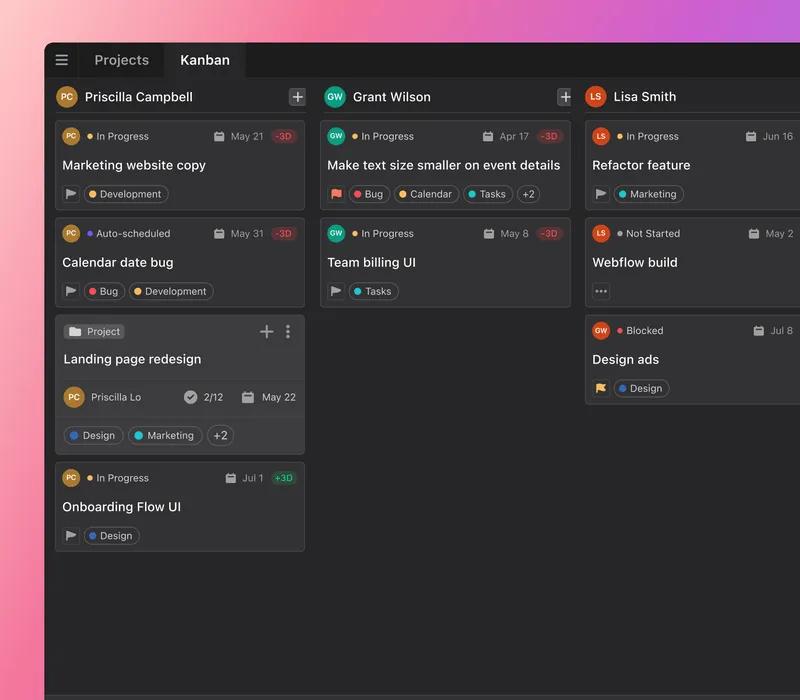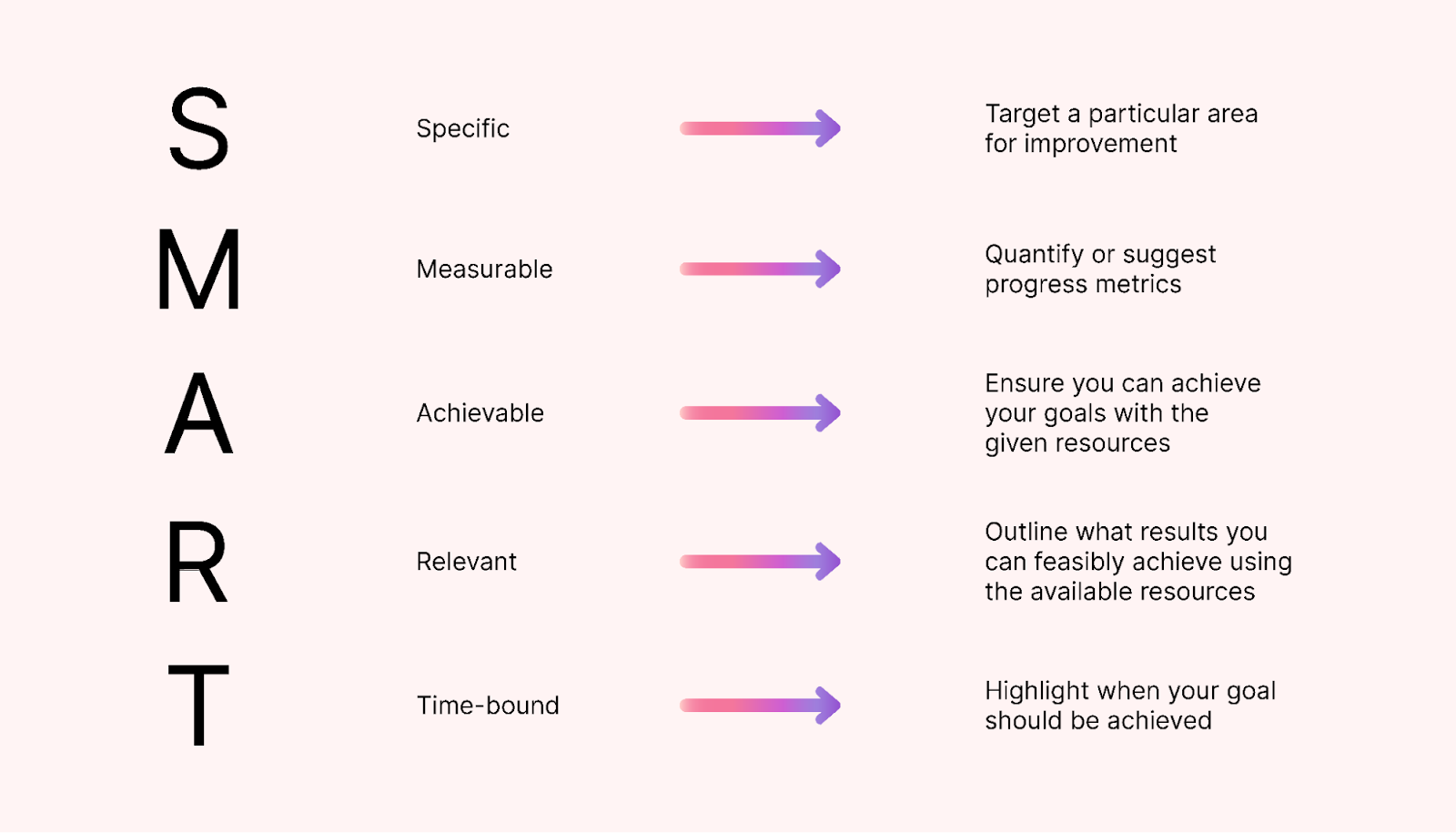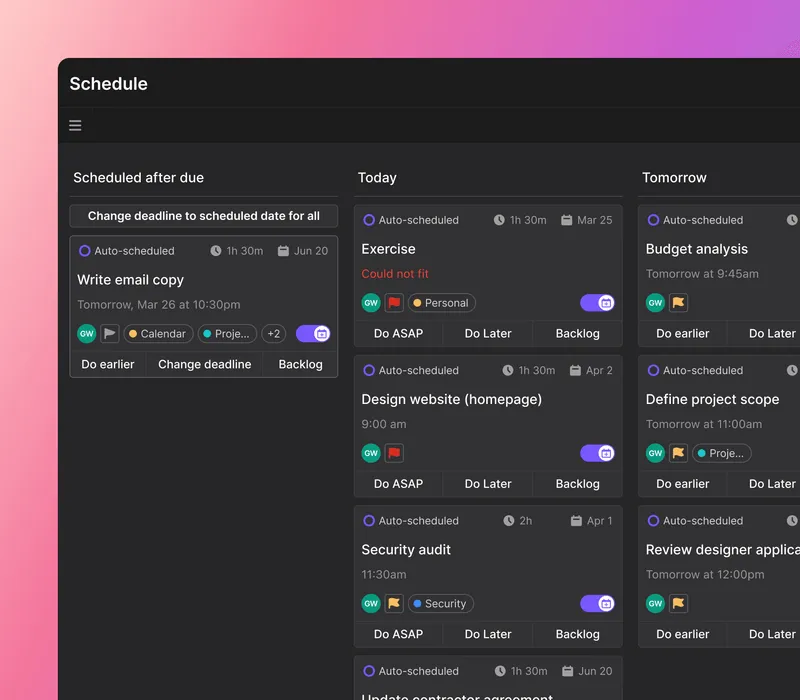Setting performance goals is a great way to boost motivation, increase productivity, and help your business grow.
But setting effective goals is easier said than done.
If you don’t set realistic goals, your motivation can take a hit. If your goals aren’t clear, it’s difficult for people to know what’s expected of them. If your goals aren’t measurable, how will you know when you’ve succeeded?
It’s a lot to think about.
The good news is that you’ve come to the right place.
In this article, we walk you through writing successful performance goals, plus a few performance goal examples to get you started on the right foot.
What are performance goals?
Performance goals are targets for measuring success. They help you track your progress and make sure your teams are hitting their targets to grow and develop the business within a defined timeframe.
Performance goals can be set for the entire company, a certain team, or an individual. Usually, managers or business leaders are responsible for creating them.
However, teams and individuals can also collaborate with upper-level staff to set their own performance goals. For example, an employee might work with their line manager to set goals around their work responsibilities.
What are the benefits of setting performance goals?
It doesn’t matter how large or small your organization is. Creating performance-based goals and striving for them has a lot of benefits.
Here are the main reasons why you should set performance goals:
To establish clear expectations
With a performance goal, team members know what they need to achieve, how to achieve it, and how long they have to get their work done. There’s no confusion or misunderstanding about what’s expected of them.
To boost motivation
Performance goals provide team members with specific targets to reach. This can increase their motivation and give them an incentive to deliver top-quality work.
Take a look at Loke and Latham’s research, for instance. Their study shows that goals motivate employees and improve performance.
To increase accountability
When employees are responsible for achieving their own goals, this can give them the boost they need to reach their targets. It can also lead to an increase in productivity, efficiency, and engagement — all of which are helpful for your business growth.
And, if you use a tool like Motion to track performance, team members can see how their colleagues are progressing with their own performance goals. Knowing that coworkers and managers can see their progress is another motivation for an employee to work hard to achieve their goals.
 |
To measure performance
Performance goals allow you to accurately track progress and determine success. This means you can identify whether someone’s work or project was successful and how to make improvements for the future.
5 performance goal examples
Take a look at these five examples of performance goals for inspiration:
1. Sales performance goal
A sales performance goal usually focuses on how a salesperson or team can increase sales. It motivates sales teams to identify and capture more leads, ultimately boosting revenue.
Here’s an example:
Achieve a 15% increase in monthly sales revenue over the next six months by growing our market share and launching targeted marketing campaigns.
This goal focuses on achieving a specific sales target, giving sales reps a clear and concise way of hitting the goal and measuring their success. It also encourages sales reps to boost their performance and close more deals.
2. Project management goal
A project management performance goal can help you improve the efficiency and quality of your projects. It can also encourage you to streamline processes, allocate resources effectively, and ensure the project is delivered on time and within budget.
Take a look at this example of a project management goal where the focus is to get rid of scope creep:
Minimize scope creep by 20% by implementing effective project communication processes and channels over the next three months.
If this goal is achieved, the project workflow will run more smoothly, and teams will be able to communicate more effectively.
3. Self-performance review goal example
Professional development performance goals are typically made to help individuals build their skill sets. They prioritize personal growth and career advancement, allowing employees to focus on training and development.
 |
Take a look at this example:
Improve leadership and communication skills by taking a leadership training course within the next three months and leading a project team from start to finish by the end of the fiscal year.
This goal would encourage an employee to develop their leadership skills and prove that their training has improved their ability to lead an entire team. As a result, the business would get a better-qualified project leader and the employee, a new set of skills — a win-win.
4. Customer service goal
Customer service goals usually involve identifying ways to improve customer satisfaction and the customer experience.
They can also help set measurable benchmarks for customer satisfaction, making it easier for customer service reps to provide customers with the best possible experience.
Here’s an example of a goal to improve customer response times:
Reduce the average response time from 24 hours to 12 hours within the next six months by using an automated ticketing system.
This particular goal will help customer service reps provide faster and more efficient service. That will improve the customer experience and give the business a positive reputation for solving customer queries.
5. Productivity goal
Productivity performance goals focus on how employees or teams can be more efficient — and produce more work as a result. They help businesses identify and minimize time-wasting activities and improve employees’ time management skills.
 |
Check out this example of a productivity performance goal:
Increase the average number of client reports by 20% within the next quarter by streamlining the report generation process into one platform.
If successful, this goal will help employees produce more reports in a shorter amount of time. It will also give employees more time to be productive in other areas of the business — essentially hitting two birds with one stone.
How do you write performance goals?
Now that you have a better idea of what performance goals are and how they work, let’s walk through some of the best practices for writing performance goals of your own.
Identify the purpose
Start by identifying what you want to achieve from the performance goal. Why? Because if there’s no purpose guiding the goal, it can feel pretty pointless to the people trying to achieve it.
When teams understand the reasons behind their goals, they’re more likely to be engaged and committed to achieving them.
Having a clear purpose also helps ensure that your goals are aligned with your business and employee needs. It helps you create goals for employees that not only support those individuals’ development but also contribute to your business’s growth. As a result, you avoid irrelevant or conflicting goals.
Plus, when employee goals align with organizational and employee needs, their performance can increase by up to 22%.
So, how exactly do you pinpoint the purpose of a performance goal?
Here’s what you can do:
1. Review your organizational goals. Take a step back and look at the broad picture of your business. What are the company’s goals? How do you plan to grow the company? Answering these questions can help ensure that the reasons behind your performance goals align with the direction of your business.
2. Consider employee skills. When you have a clear picture of your company’s goals, you can start to think about how employee skills feed into the bigger picture. Are there any gaps in employees’ skill sets? Would it help your business grow if certain employees completed training in new topics or developed new soft skills?
With this in mind, you can create professional development goals for employees that also support the business as a whole.
Use the SMART goals framework
The SMART goals framework can help you create clear performance goals that make measuring success easy. As a result, everyone on the team has a foolproof understanding of what they need to do, how their goals can be achieved, and what the outcomes should be.
SMART stands for Specific, Measurable, Achievable, Relevant, and Time-bound. Let’s take a look at how it works:
 |
Here’s an example of a SMART performance goal:
Reduce customer churn by 20% in the next financial year by implementing follow-up processes and enhancing customer service training.
All the examples above are SMART goals, so feel free to use these as inspiration.
Share the performance goals with your employees
Provided you didn’t come up with the performance goals with your employees, you’ll need to share them. This will give the employees a chance to review the goals, talk them through with you, and ask for any changes they’d like made.
Here’s how this process works:
1. Share your goal suggestions. You can either do this online or in person — it’s up to you. However, if you do decide to do it online, it’s a good idea to be on a call with the person at the same time (you can use Motion’s Meeting Assistant to schedule this meeting).
You want to walk through the goals, explaining the purpose behind them and how they’ll help the business grow. If you simply share the goals via email with no explanation, your team members might struggle to understand their importance.
2. Discuss feedback. Employees may have questions about the goals, so allow some time to discuss the specifics of each one to help ensure that everyone’s on the same page going forward and employees get a chance to voice their opinions.
3. Amend the goals as necessary. During your constructive feedback discussion, you and your employees might come across some areas for improvement or necessary changes to the performance goals. If you agree with their input, you can make revisions to reflect it.
Using an online platform like Motion is particularly helpful here. With it, you can update your goals for everyone to see — no matter where they’re working — in a matter of clicks.
Use technology to track performance
Having the right technology in place can be incredibly helpful for tracking your performance goals.
Think about what it takes to make sure your goals are progressing without a digital platform. Sure, you can track milestones along the way that can keep tabs on progress, but this doesn’t give you instant access to performance.
An online work management tool like Motion helps you keep on top of performance goals in real time. As a result, you can make sure you and your team are on track to achieve your goals. And if things aren’t going to plan, you can make changes to get things back on schedule.
 |
Plus, Motion’s platform provides other tools and features to help improve your work performance. Collaborate with colleagues, seamlessly manage work schedules, and prioritize tasks to deliver the most important work on time.
Track your performance goals with Motion
Performance goals are beneficial for businesses in any industry. They boost employee motivation, provide accountability, and help you measure success to make informed decisions about business growth.
The examples in this article are a good starting point for creating your own successful goals. Follow the steps listed above to write your own goals from scratch.
If you’re looking for a platform to launch (and help you track and manage) your performance goals, consider Motion. Our work management platform facilitates goal-setting and collaboration between teams, allowing you to share updates and track performance goals in real time.
Sign up for a free trial to get started!





